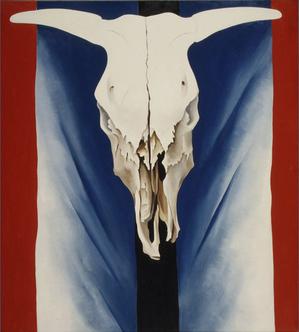| Cow's Skull: Red, White, and Blue | |
|---|---|
 | |
| Artist | Georgia O'Keeffe |
| Year | 1931 |
| Medium | oil paint, canvas |
| Dimensions | 101.3 cm (39.9 in) × 91.1 cm (35.9 in) |
| Location | Metropolitan Museum of Art |
| Accession no. | 52.203 |
| Identifiers | The Met object ID: 488694 |
Cow's Skull: Red, White, and Blue is a painting by American artist Georgia O'Keeffe. It depicts a cow skull centered in front of what appears to be a cloth background. In the center of the background is a vertical black stripe, surrounded by two vertical stripes of white laced with blue. Outside are two vertical red stripes.
O'Keeffe created the 39 7/8 x 35 7/8-inch (101.3 x 91.1 cm) oil painting on canvas in 1931. Around that time, American artists sought themes for the "Great American Novel" or "Great American Story". [1] It is part of the Alfred Stieglitz Collection (1952) of the Metropolitan Museum of Art. [1]